How to Provide Safe and Secure Transport to Your Customers
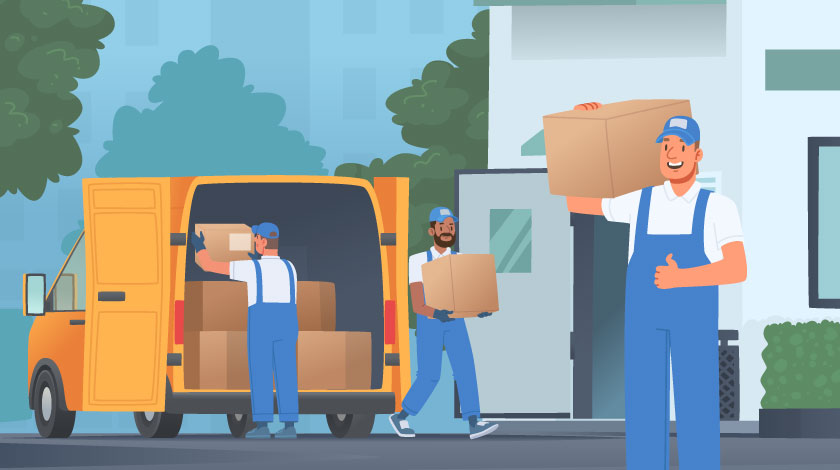
Ensuring the safety and security of goods during transit is a fundamental concern for logistics and moving companies. The consequences of mishandling customers' items can be significant, leading to damaged goods, dissatisfied customers, and potential financial losses. This is why it’s crucial for businesses involved in the transportation of goods to prioritize secure packing, careful handling, and reliable transportation methods.
In this blog, we will dive into essential strategies to uphold the security of goods in transit. We’ll cover comprehensive packing tips to protect items from damage, best practices for handling goods to avoid accidents, effective transportation methods that ensure safety throughout the journey, and effective communication strategies to keep customers reassured about the safety of their goods.
Importance of Safe Transportation
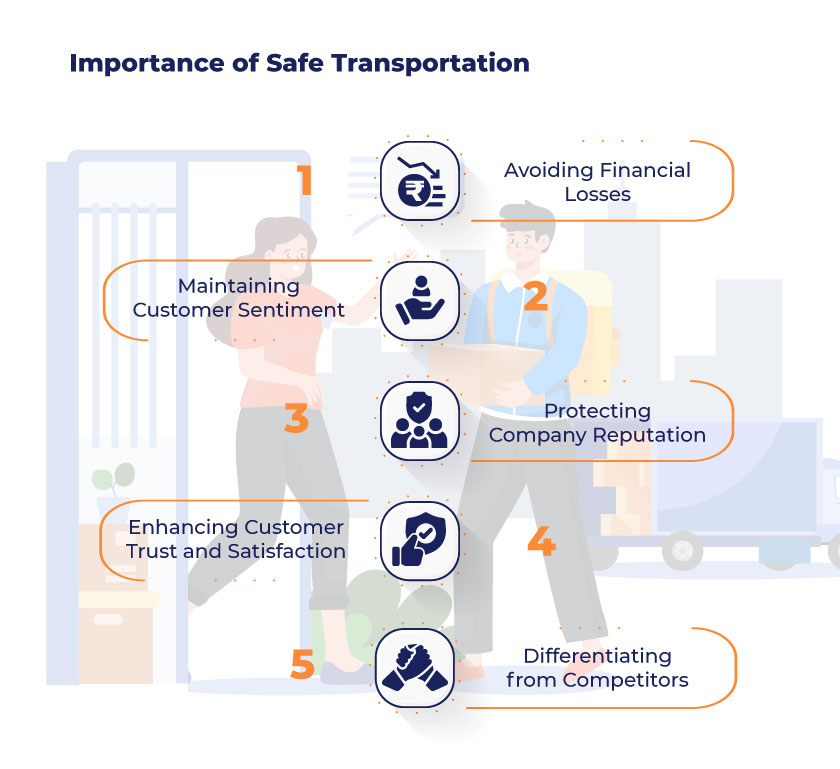
Ensuring the safe transportation of goods is crucial for several reasons, including:
- Avoiding Financial Losses: Unsafe handling and transportation can lead to physical damage to products, resulting in direct costs like replacement or repair. Furthermore, if these goods are integral to business operations, damage can disrupt supply chains and impact production or sales, leading to further financial repercussions.
- Maintaining Customer Sentiment: Beyond the financial aspect, damage to personal belongings can affect customers on a sentimental level. This emotional impact can lead to dissatisfaction and harm the business's relationship with its customers.
- Protecting Company Reputation: The reliability and safety of transportation are directly linked to a company's reputation. Mishandling or damage can result in negative reviews and a tarnished image, which can be costly and difficult to repair. In an era where online reviews can shape public perception, maintaining a good reputation is crucial.
- Enhancing Customer Trust and Satisfaction: Rigorous safety measures build customer trust and demonstrate that a company values its clients' goods. This can lead to increased customer loyalty, repeat business, and positive referrals, all of which are valuable in a competitive market.
- Differentiating from Competitors: A commitment to the safe transportation of goods can set a company apart from its competitors, making it the preferred choice for customers who prioritize the security of their shipments.
Packing Tips for Safety
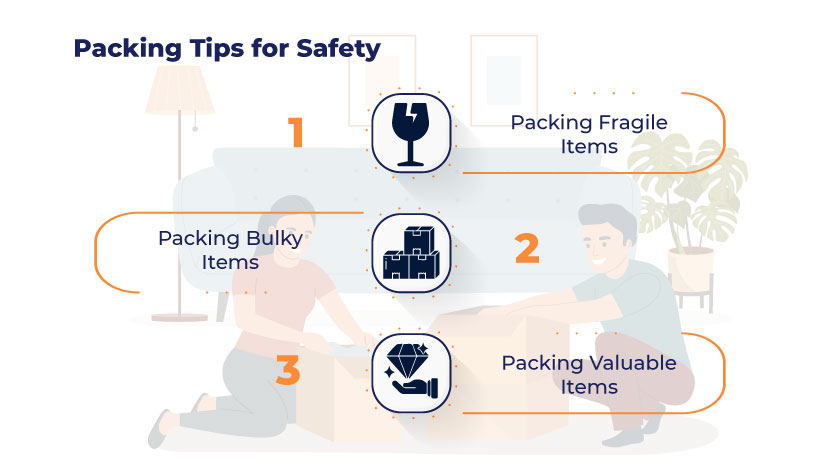
Proper packing is essential to ensure the safety of goods during transit, particularly for items that are fragile, bulky, or valuable. Here are detailed guidelines and suggestions for materials and techniques that can be used to secure these items effectively:
1. Packing Fragile Items:
- Materials: Use high-quality packing materials such as bubble wrap, packing peanuts, foam pads, and sturdy cardboard boxes that are size-appropriate.
- Technique: Wrap each fragile item individually in bubble wrap, securing the wrap with tape. Cushion the bottom of the box with foam pads or packing peanuts before placing the wrapped items inside. Fill any remaining space with additional packing peanuts to prevent movement during transit. Seal the box with heavy-duty packing tape and clearly mark it as "Fragile."
2. Packing Bulky Items:
- Materials: Use strong, corrugated cardboard boxes or custom wooden crates for extremely large items. Ensure the use of heavy-duty straps and padding materials like blankets or bubble wrap.
- Technique: Disassemble parts of bulky items if possible to reduce their size and make them easier to handle. Wrap each part separately in blankets or bubble wrap for protection. Securely strap the items within the box or crate to prevent shifting. If using a box, fill gaps with additional padding to ensure there's no movement.
3. Packing Valuable Items:
- Materials: Opt for high-security materials like hard-shell cases or strong, lockable boxes. Use anti-static bubble wrap for electronic items to prevent damage from static electricity.
- Technique: Double-box valuable items by placing a smaller box inside a larger one, both filled with shock-absorbing materials like foam inserts or bubble wrap. This provides an extra layer of protection against impacts. For extremely valuable or sensitive items, consider using sealed, waterproof containers or bags to protect against moisture and dust.
Best Practices in Handling Goods
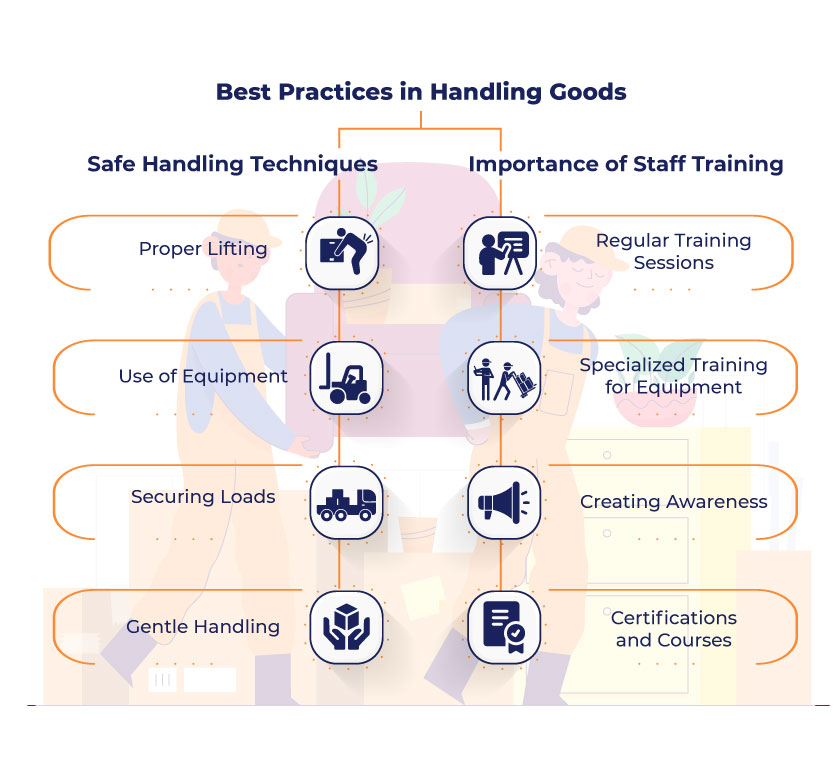
Handling goods safely during loading and unloading is crucial to prevent damage and ensure the security of the items being transported. Proper techniques and well-trained staff are key components of effective handling practices. Here are some insights into these aspects:
1. Safe Handling Techniques:
- Proper Lifting: Teach staff the importance of lifting with their legs, not their back, to prevent injuries. This is especially important for heavy items, where team lifting may also be necessary.
- Use of Equipment: Utilize appropriate handling equipment such as dollies, hand trucks, and forklifts for heavier or bulkier items. This not only eases the load but also minimizes the risk of dropping or mishandling.
- Securing Loads: Ensure that all items are securely fastened and balanced in the transport vehicle. Use straps, bungee cords, or secure nets to keep items from shifting or falling during transit.
- Gentle Handling: Emphasize the importance of handling each item with care, especially fragile or valuable goods. Avoid throwing or sliding boxes as these actions can damage the contents inside.
2. Importance of Staff Training:
- Regular Training Sessions: Conduct regular training sessions to keep all team members updated on the latest safety protocols and handling techniques. This should include both new hires and experienced staff to ensure consistent handling standards across the board.
- Specialized Training for Equipment: Provide specific training for any equipment used in the moving process. Ensuring that all personnel are competent in operating such machinery is crucial for safety.
- Creating Awareness: Educate employees about the potential consequences of mishandling, including damage to goods, customer dissatisfaction, and possible injuries. Awareness helps in fostering a culture of care and responsibility.
- Certifications and Courses: Encourage or require certifications for advanced handling techniques, particularly for staff involved in the transport of high-value or particularly fragile items.
Secure Transportation Methods
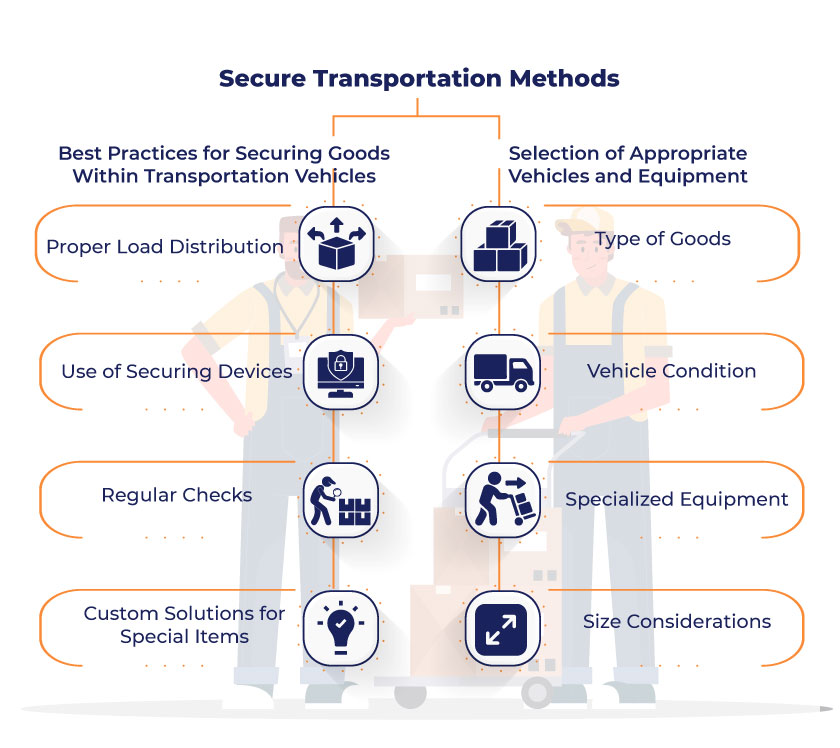
Ensuring that goods remain safe and intact throughout their journey requires meticulous attention to how they are secured within transportation vehicles and the selection of appropriate vehicles and equipment. Here are some best practices and considerations for secure transportation:
1. Best Practices for Securing Goods Within Transportation Vehicles:
- Proper Load Distribution: Balance the weight evenly across the vehicle to prevent shifting during movement. This stability is crucial for avoiding damage, especially during sharp turns or sudden stops.
- Use of Securing Devices: Employ straps, tie-downs, and cargo bars to secure items firmly in place. For delicate items, use cushioning materials like air bags or foam between the cargo and securing devices to avoid damage from pressure points.
- Regular Checks: Conduct regular checks during transit, especially on long journeys, to ensure that securing devices are holding up and have not loosened.
- Custom Solutions for Special Items: For unusually shaped, oversized, or particularly fragile items, consider custom solutions like tailored brackets or supports that can provide additional stability and protection.
2. Selection of Appropriate Vehicles and Equipment:
- Type of Goods: Match the type of goods with the appropriate vehicle. For example, perishable goods require refrigerated trucks, while valuable artworks might need vehicles with enhanced security features or climate controls.
- Vehicle Condition: Ensure that the vehicles are well-maintained and suitable for the load they are carrying. Regular maintenance checks should include tire inspections, brake tests, and verification of all safety equipment.
- Specialized Equipment: Use specialized equipment such as air-ride suspension systems for extremely delicate items that are sensitive to vibrations and shocks. Consider using vehicles with hydraulic lift gates for easy loading and unloading of heavy items.
- Size Considerations: Choose the vehicle size according to the volume and weight of the load. Overloading can lead to unsafe driving conditions and increase the risk of accidents and damage.
Technology and Tools for Transport Security
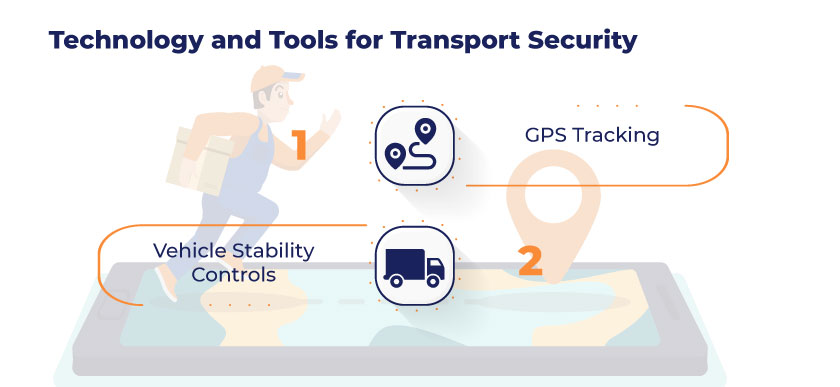
Several advanced technologies are available that can significantly improve how goods are handled and transported securely. Here's a look at some key technologies and how they contribute to the secure transport of goods:
1. GPS Tracking:
- Functionality: GPS (Global Positioning System) tracking devices are installed in transportation vehicles to monitor their routes and locations in real-time. This technology allows logistics companies to track every movement of the cargo from start to finish.
- Benefits: GPS tracking enhances security by providing continuous visibility of the goods. In case of deviations from the planned route or unexpected stops, alerts can be triggered. It also helps in planning more efficient routes and reducing delays.
2. Vehicle Stability Controls:
- Functionality: Vehicle stability control systems are critical for ensuring that vehicles carrying goods maintain traction and stability under various driving conditions. These systems automatically apply brakes or adjust engine power to prevent skidding or tipping, especially when vehicles are navigating rough terrain or adverse weather conditions.
- Benefits: This technology is crucial for preventing accidents that could damage goods. Ensuring that vehicles are stable during transport reduces the risk of mishaps due to sudden movements, contributing to the overall safety of the cargo.
Communicating Safety Measures to Customers
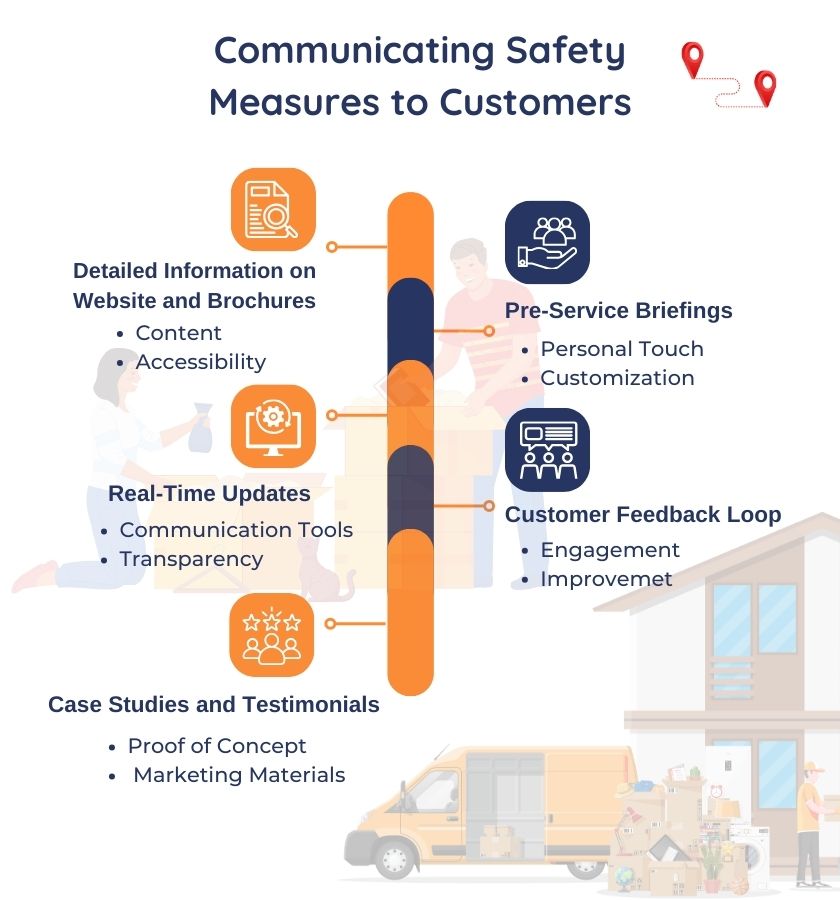
Transparency in your operations, especially concerning how their goods are handled and transported, can significantly enhance customer satisfaction and loyalty. Here are some strategies for effectively communicating your safety measures:
1. Detailed Information on Website and Brochures:
- Content: Clearly outline the safety protocols and technologies you use on your website and in brochures. Provide detailed descriptions of how these measures protect their goods and ensure secure transit. This could include information about GPS tracking, vehicle stability controls, automated loading systems, and any other security measures you have in place.
- Accessibility: Make this information easy to find and understand. Use diagrams, infographics, or videos to visually explain complex technologies and processes.
2. Pre-Service Briefings:
- Personal Touch: Before a service begins, have a representative personally explain the safety measures to the customer. This could be during a pre-move consultation or via a planning call.
- Customization: Tailor the information to the specifics of the customer’s goods. For instance, if a customer is concerned about fragile items, highlight how your packing and vehicle stability systems will protect those items specifically.
3. Real-Time Updates:
- Communication Tools: Utilize SMS, email, or a mobile app to provide real-time updates during the transit process. Inform customers when their goods are loaded, in transit, and nearing delivery.
- Transparency: Include information on any changes or issues that arise and explain how your safety protocols are addressing them. For example, if a delay occurs, communicate what measures are in place to ensure the security and safety of their goods during the extended transit time.
4. Customer Feedback Loop:
- Engagement: After delivery, invite customers to provide feedback on the safety and security of their shipment. This not only shows that you value their opinion but also helps you gauge the effectiveness of your communication about safety measures.
Also read: Importance of Customer Feedback
- Improvement: Use this feedback to improve how you communicate your safety protocols. Learning directly from customer experiences can provide valuable insights into what works and what might need more clarity.
5. Case Studies and Testimonials:
- Proof of Concept: Share case studies and testimonials that showcase successful deliveries where your safety measures played a crucial role. This real-life proof can significantly reassure new or prospective customers.
- Marketing Materials: Incorporate these testimonials in your marketing materials and on social media to broadcast the effectiveness of your safety measures to a wider audience.
Safe Delivery, Happy Customers
For businesses in the logistics and moving sectors, implementing safe and secure transport strategies is not just about fulfilling a need—it's about elevating your service quality and securing a competitive edge. By adopting these best practices, your business can demonstrate a commitment to safety and reliability that distinguishes you from competitors and fosters lasting customer relationships.
Let this guide inspire you to integrate these safety protocols into your operations. The benefits of doing so—increased customer trust, fewer incidents of damage, and enhanced overall service satisfaction—are integral to navigating high-demand seasons successfully. Remember, when your customers feel confident that their goods are in safe hands, they not only become repeat customers but also your best advocates in the marketplace.
Also read: Resolving Moving Conflicts with Grace